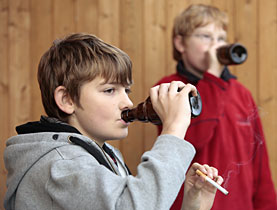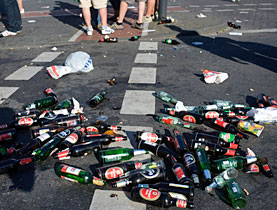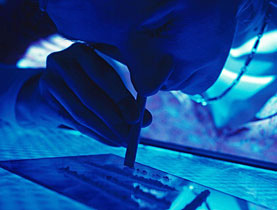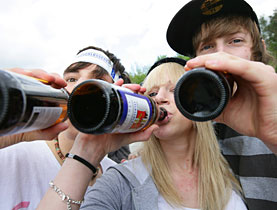Drinking among youth remains a big problem

Alcohol consumption among Swiss youth continues to be a major health risk and should not be underestimated, experts say, despite a decline in drinking since 2002.
Drinking alcohol is still at a high level, with 14 per cent of 13-year-olds getting drunk at least once a month, the Swiss Institute for the Prevention of Alcohol and Drug Problems reported on Tuesday.
The Lausanne-based organisation called for stricter control measures, arguing that alcohol was too easy to obtain in Switzerland and too cheap.
A study carried out by the European School Survey Project on Alcohol and Other Drugs has revealed that almost 50 per cent of 13-year-olds in Switzerland had consumed alcohol in the 30 days before the representative survey was made.
Corine Kibora, spokeswoman at the Swiss institute, said the figures were of particular concern.
“They are young adolescents and at that age drunkenness has two kinds of risks. The immediate risks include aggression, fighting, non-desired and possibly non-protected sex, falls, accidents and damage to public property… If consumption is too excessive young people could fall unconscious and go into a coma,” she told swissinfo.
The other kind of risk, she explained concerned addiction to alcohol.
Risk of dependence
“There is a danger that the younger you start to consume alcohol in large amounts, the more you run the risk of having problems linked to alcohol in later life and even dependence.”
The institute has also noted that alcohol is easy to buy in Switzerland and prices are low enough for young people to afford.
A number of factors have contributed to this situation, including deregulation of the alcohol market and a lowering of taxes in some instances.
“That has meant that the number of places where you can buy alcohol has multiplied. Spirits also came down in price because of the harmonisation of tax in Europe in 1999. Alcohol is easily available and the prices aren’t high enough,” Kibora said.
The study showed that in 2007, 40 per cent of 13-year-old boys and 55 per cent of girls of the same age were able to buy alcohol in bars, restaurants and discotheques.
“We want protection measures for young people to be better applied,” Kibora said.
Room for improvement
Although admitting that the situation had improved in recent years, there was still room for improvement, she added.
“It is not always easy for a salesperson under stress to ask for some kind of identity when a young person wants to buy alcohol,” she said.
Kibora commented that generally employers were now more responsible in training their staff than had been the case a few years ago but there were still problems.
More effort was needed to train sales staff in difficult situations, for example asking for some kind of identity or handling a young person who became irritated.
The institute also emphasised the importance of the behaviour of parents in prevention measures.
“We know that in families where there is dialogue and a certain trust between parents and children, in which parents know where their children are and what they are doing, there are generally fewer problems.”
“But parents also have to be supported because they can’t do everything. I think most parents do the best they can. I believe adults at all levels should help in prevention measures to protect young people,” Kibora added.
swissinfo, Robert Brookes
The overall aim of the Espad is to study adolescent substance use in Europe from a comparative and long-term perspective.
The target population of project is students who turn 16 years old during the calendar year of the data collection.
The basic goal is to collect comparable data on the use of alcohol, tobacco and other drugs among students throughout European countries.
Data is collected in cooperation between countries using a strictly standardised methodology, in order to offer as comparable results as possible.
The 2007 report has information on 35 European countries.
The results from Switzerland are all very close to the Espad mean except concerning the lifetime prevalence of cannabis use (33%), which is well above average.
The majority (85%) of the students had consumed alcohol during the past 12 months and 41 percent had been drunk during the same period.
Almost one third (29%) of the students had been smoking cigarettes during the past 30 days.
In contrast to cannabis consumption, the reported use of drugs other than cannabis (7%) equals the mean for all countries.
Nine percent reported use of inhalants, eight percent had used tranquillisers or sedatives without a prescription, and six percent had combined pills with alcohol.
Swiss law prohibits the sales of beer and wine to those under 16. Spirits and alcopops may only be sold to those over 18.

In compliance with the JTI standards
More: SWI swissinfo.ch certified by the Journalism Trust Initiative




You can find an overview of ongoing debates with our journalists here. Please join us!
If you want to start a conversation about a topic raised in this article or want to report factual errors, email us at english@swissinfo.ch.